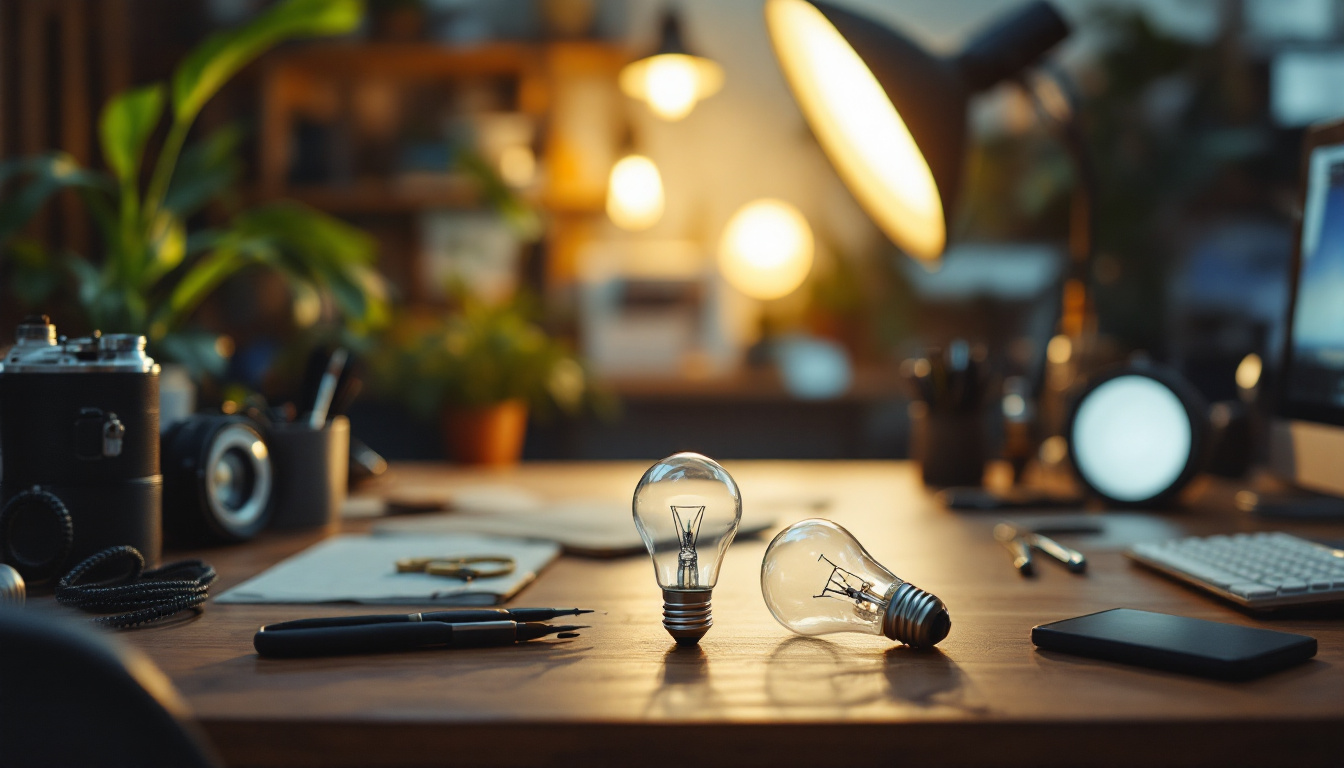
As the world of lighting continues to evolve, LED light bulbs have become a staple in various commercial settings, including shops and retail environments. For lighting contractors, staying updated on the latest trends in LED technology is crucial for providing clients with the best solutions. This article delves into the current trends in LED light bulbs that every lighting contractor should be aware of, ensuring they can offer informed recommendations to their clients.
One of the most significant trends in the lighting industry is the integration of smart technology into LED lighting solutions. Smart LED bulbs offer enhanced control and customization, allowing users to adjust brightness, color temperature, and even create lighting schedules through smartphone applications or voice-activated devices. This innovation not only caters to the convenience of modern consumers but also aligns with the growing demand for energy-efficient solutions that contribute to sustainability.
Smart LED lighting provides numerous advantages for shop owners. For instance, it can lead to energy savings by allowing users to turn off lights remotely or schedule them to operate only during business hours. Furthermore, the ability to change color temperatures can create different atmospheres within the shop, enhancing the shopping experience and potentially increasing sales. Research has shown that specific lighting conditions can influence consumer behavior, with warmer tones encouraging relaxation and cooler tones promoting alertness, thus strategically guiding customers through their shopping journey.
Additionally, smart LED systems can be integrated with other smart technologies, such as security systems and HVAC controls, creating a cohesive environment that enhances both safety and comfort. By utilizing sensors that adjust lighting based on occupancy, shop owners can further optimize energy usage, ensuring that lights are only on when needed. This level of automation not only reduces costs but also contributes to a more environmentally friendly business model, appealing to eco-conscious consumers.
Many smart LED bulbs are designed to be compatible with existing lighting systems, making it easier for contractors to upgrade a shop’s lighting without extensive rewiring. This adaptability is particularly appealing to shop owners who may be hesitant to invest in a complete overhaul of their lighting infrastructure. Furthermore, the ease of installation means that businesses can quickly reap the benefits of smart lighting without significant downtime, allowing them to maintain a seamless operation while enhancing their environment.
Moreover, the growing ecosystem of smart lighting solutions means that shop owners can choose from a variety of products that suit their specific needs, whether they are looking for decorative fixtures or functional task lighting. Many manufacturers offer comprehensive support and resources to help businesses select the right products and integrate them effectively into their existing systems. This flexibility not only empowers shop owners to tailor their lighting to their unique brand identity but also ensures that they remain competitive in an ever-evolving retail landscape.
Energy efficiency remains a top priority for many businesses, and LED light bulbs are at the forefront of this movement. Compared to traditional incandescent and fluorescent bulbs, LEDs consume significantly less energy, which translates into lower utility bills for shop owners. In fact, studies have shown that switching to LED lighting can reduce energy consumption by up to 80%, providing a substantial return on investment over time. This not only helps businesses save money but also contributes to a reduction in overall carbon emissions, aligning with global efforts to combat climate change.
In addition to their energy efficiency, LED bulbs boast a longer lifespan, often lasting up to 25,000 hours or more. This longevity not only reduces the frequency of bulb replacements but also minimizes waste, making them a more sustainable choice for environmentally-conscious businesses. Lighting contractors should emphasize these benefits when discussing options with clients. Furthermore, the durability of LED bulbs means they are less likely to break or fail, which can be particularly advantageous in high-traffic areas or challenging environments. This resilience can lead to fewer disruptions in business operations, allowing for a smoother customer experience.
Many regions offer incentives or rebates for businesses that choose energy-efficient lighting solutions. Contractors should stay informed about local programs that can help shop owners offset the initial costs of upgrading to LED lighting. This financial incentive can be a persuasive selling point when discussing the benefits of LED technology. Additionally, some utility companies provide energy audits and personalized recommendations, further supporting businesses in their transition to more sustainable practices. By taking advantage of these programs, shop owners can not only enhance their lighting but also improve their overall operational efficiency, paving the way for a more sustainable future.
The Color Rendering Index (CRI) is a critical factor that lighting contractors should consider when recommending LED bulbs for shops. CRI measures how accurately a light source displays colors in comparison to natural light. For retail environments, where product presentation is vital, a higher CRI can make a significant difference.
For most retail applications, a CRI of 90 or above is recommended. This high level of color accuracy helps products appear more vibrant and appealing to customers, enhancing the overall shopping experience. Contractors should educate clients about the importance of CRI and guide them in selecting LED bulbs that meet their specific needs.
Lighting plays a crucial role in shaping a customer’s perception of a shop. Poor lighting can lead to a negative shopping experience, while well-lit spaces can encourage customers to linger and explore. By choosing LED bulbs with a high CRI, contractors can help shop owners create inviting atmospheres that attract and retain customers.
As LED technology continues to advance, the design options available for LED bulbs have expanded significantly. Contractors can now offer a variety of styles, shapes, and finishes to suit the aesthetic preferences of their clients.
From vintage-style Edison bulbs to sleek, modern fixtures, the versatility of LED lighting allows for greater customization in shop design. Contractors should keep an eye on emerging design trends to ensure they can provide clients with the latest options that align with their branding and interior design choices.
LED lighting can be seamlessly integrated into architectural features, such as shelves, displays, and signage. By utilizing LED strips or recessed lighting, contractors can create a cohesive look that enhances the overall design of the shop while providing effective illumination. This integration not only improves aesthetics but also highlights products in a way that draws customers’ attention.
In recent years, there has been a growing awareness of the impact of lighting on health and well-being. LED lighting can be tailored to support the physiological needs of individuals, making it an important consideration for shop environments.
Human-centric lighting refers to lighting designed to support the natural circadian rhythms of individuals. By adjusting color temperatures throughout the day, contractors can help create environments that promote alertness during business hours and relaxation during closing hours. This approach can lead to improved employee productivity and customer satisfaction.
Proper lighting can also reduce eye strain and fatigue, particularly in retail environments where staff may spend long hours under artificial lighting. By selecting LED bulbs that provide adequate illumination without harsh glare, contractors can contribute to a more comfortable working environment for employees, ultimately benefiting the shop’s overall performance.
While the initial investment in LED lighting may be higher than traditional options, the long-term cost savings make them a cost-effective choice for shop owners. Lighting contractors should be prepared to discuss the financial implications of switching to LED technology.
When presenting LED options to clients, contractors can help them calculate the return on investment (ROI) by comparing energy costs, maintenance expenses, and potential savings over time. This data-driven approach can help clients understand the long-term benefits of investing in LED lighting.
Some contractors may offer financing options to help shop owners manage the upfront costs of upgrading to LED lighting. By providing flexible payment plans, contractors can make it easier for clients to embrace modern lighting solutions without straining their budgets.
The LED lighting industry is continuously evolving, and staying ahead of future trends is essential for lighting contractors. Emerging technologies and innovations will shape the way LED lighting is used in shops and commercial spaces.
As research and development in LED technology progress, contractors can expect to see even more efficient and high-performance lighting solutions. This includes advancements in lumens per watt, which will further reduce energy consumption while maintaining high-quality illumination.
With the growing emphasis on sustainability, the integration of LED lighting with renewable energy sources, such as solar power, is becoming more prevalent. Contractors should be prepared to explore these options with clients who are looking to further reduce their carbon footprint and energy costs.
LED light bulbs are transforming the way shops approach lighting, offering energy efficiency, design flexibility, and enhanced customer experiences. For lighting contractors, understanding the latest trends in LED technology is essential for providing clients with informed recommendations. By staying updated on smart lighting, CRI considerations, health impacts, and future advancements, contractors can position themselves as knowledgeable experts in the field.
As the demand for LED lighting continues to grow, contractors who embrace these trends will be well-equipped to meet the evolving needs of their clients and contribute to the success of their businesses. Whether it’s through energy savings, improved aesthetics, or enhanced well-being, the benefits of LED lighting are clear, making it an indispensable component of modern shop design.
Ready to elevate your lighting game and give your clients the cutting-edge LED solutions they deserve? Look no further than LumenWholesale. We provide lighting contractors with the highest quality, spec-grade LED products at unbeatable wholesale prices. Say goodbye to local distributor markups and hello to superior lighting that meets the strictest industry standards. Plus, with free shipping on bulk orders, you can stock up on premium lighting without any hidden fees. Don’t compromise on quality or value; choose LumenWholesale for all your lighting needs. Wholesale Lighting at the Best Value is just a click away.

Discover the pitfalls lighting contractors often encounter with LED exterior flood lights.

Discover why LED strip lights are revolutionizing the lighting industry and what every contractor needs to know to stay ahead.

Explore how wiring connectors play a crucial role in enhancing energy efficiency.

Discover the ultimate guide to halide bulbs with our essential checklist tailored for lighting professionals.